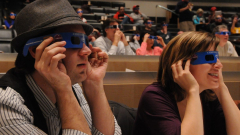Celebrate USA TODAY’s 40th anniversary with these 40 moments when the newspaper made a difference to its readers, our nation and its staff.
David Colton
Special to USA TODAY
Published
Updated
Coming up with a Top 40 in the era of Everything Goes Viral can only spark endless arguments and “whataboutism.”
But everyone loves round numbers, and USA TODAY’s 40th anniversary – remember, some predicted it would not last 40 weeks – should not be ignored. And what better way to celebrate than highlighting 40 moments to mark our anniversary on Sept. 15?
How to do it? We did not want simply an almanac-type list of the 40 biggest stories over four tumultuous decades. Even using circulation figures (old metric) or pageviews (new), measuring journalism goes beyond audience, although (a nod to reality), audience is always nice.
No, the best way to measure journalism, we decided, was by its impact. Did our reporting change things for the better? Hold people accountable? Right hidden wrongs? Or sometimes bring a smile? Was our writing memorable, our photography compelling, our graphics fact-filled?
And did USA TODAY’s brash new way to deliver the news – short and to the point with lots of entry points and color – mark an inflection point for the newspaper industry that at first rejected us? Or did it, as some smartly think, serve as a template for the internet?
Impact seemed a better way to go. So this will not be a listing of the biggest events of the past 40 years, although USA TODAY did cover seven presidents (from Reagan to Biden), three impeachments (Clinton and Trump twice, all acquitted), the 9/11 terror attacks and ensuing wars, along with 21 Olympics, 39 Super Bowls, several recessions, the death of the King of Pop (Michael Jackson), a princess (Diana), and one Trial of the Century (O.J. Simpson).
What became apparent as we flipped through 480 months of news was how often USA TODAY made a difference:
- TV ads during the Super Bowl were becoming big business, but were they effective? We brought political focus group thinking to coverage, unveiling the USA TODAY Super Bowl Ad Meter at Super Bowl XXIII in 1989. Now an online perennial, it has been a part of the Big Game ever since.
- From the start, USA TODAY pushed for diversity, within its newsrooms and in the culture. An examination of Supreme Court clerks in 1998 found only 2% were Black; entertainment reporters in 2016 revealed that movies and TV shows continued to fail at representing minorities, in front of or behind the cameras.
- Want impact? Our coverage in 1998 of how dangerous air bags were to children sitting in front seats, helped lead to the warning sticker now found inside car windshield visors. In 2014, then-Defense Secretary Robert Gates told Congress he learned about better ways to protect U.S. troops from roadside bombs from USA TODAY.
- We offered unprecedented looks at the inner games of sports – annual looks at how much college coaches were paid, the lack of diversity of NFL coaches, expanded baseball statistics and every Olympics event every day. We also opened up the world of high school sports, even naming high school athletes of the year. (A shortstop from Kalamazoo, Michigan, Derek Jeter, was high school player of the year in 1992.)
- And we had fun. One reporter, Tim Friend, visited the Titanic and climbed Mount Everest. Another, former Life editor Alison Maxwell, co-hosted an episode of “Project Runway.” Music critic Edna Gunderson was on a first-name basis with Bob Dylan and the Rolling Stones. And the late Olivia Barker was offered the chance to be a Miss America contestant and bravely wrote about it.
Through the 40 years, USA TODAY has grown, evolving from print-bound features and focusing instead on videos, interactives and its growing website, routinely among the top news sites with 100 million monthly visitors.
What follows are 40 moments, chosen by dozens of current and former staffers, when USA TODAY made a difference to our readers, our nation or to our staff.
David Colton is a former executive editor of USA TODAY.

What got most of the attention on Day One was on the back of the News section: the USA TODAY Weather Page.
Readers loved it – a giant color map of the USA, with temperatures and forecasts from hundreds of cities, perfect for business travelers for whom USA TODAY was designed. The newspaper industry, which for years tucked local weather into gray columns inside, took notice as well.
FIRST USA TODAY WEATHER PAGE
“It’s amazing how many color weather pages debuted in newspapers in late ’82 and ’83,” joked Richard Curtis, USA TODAY’s longtime design chief. “It was about the most groundbreaking thing about USA TODAY.” In a survey, Curtis said, “the Weather Page came out as the second most-looked-at page after Page One.”
To avoid others copying the map, the page’s award-winning designer, George Rorick, used an old cartographer’s trick and added four intentional errors to the map – an inlet here, a bump in a boundary there – as an “aha!” if another newspaper tried to lift the map whole.
And in a tribute to USA TODAY’s founder, Al Neuharth, his birthplace in the tiny South Dakota town of Eureka (pop. 992), was added later to fill a blank area on the map. It’s no longer there, but civic groups and radio stations lobbying for their own towns often questioned Eureka’s inclusion. Our only answer: It’s good to be the boss.

The 1984 Summer Olympics were planned for Los Angeles, seemingly a Perfect 10 for the young USA TODAY. But the tradition-bound Olympics Committee granted the paper only two photo credentials to cover the event. By 1996, all that changed. USA TODAY staffers entered Atlanta with 120 credentials, so many that other outlets complained.
And a reporting army was formed. Unlike other news organizations, USA TODAY covered every event, printed a daily special section for the full two weeks, and continually updated its website. And the coverage was, yes, USA-centric. “We don’t have a local team,” said then-Sports Managing Editor Monte Lorell. “Team USA – that’s our home team.”
PHOTO BY H. DARR BEISER, USA TODAY
USA TODAY reporters, photographers, graphic artists and videographers have chronicled every pole vault and slalom, from stars (gymnasts Mary Lou Retton in 1984 and the reluctant Simone Biles in 2020) to miracles (USA hockey in 1984), tragedies (the Atlanta bombing in 1996) and scandals (Tonya Harding’s ex-husband attacking the knee of rival Nancy Kerrigan in 1994).
From a production standpoint, the Olympics allowed USA TODAY to experiment with Saturday editions and fast turnarounds. In 1996, vendors handed out copies of the paper with a photo from the closing ceremony as people left the stadium. “It was a great competitive edge,” Lorell said. “Atlanta sort of stamped us as the Olympic newspaper.”
From the start, Rudy Martzke’s edgy look at how TV covered sports every weekend became a must-read column – at least among network sports executives – every Monday morning.
By 1985, Martzke’s column had become white-hot – truthfully, and sometimes ruthlessly, critiquing sports announcers from the previous weekend, making stars and sometimes enemies along the way (his feud with Howard Cosell was legendary). His column was obsessive and relentless, pointing out that a camera at an NFL game missed a crucial replay, or that an announcer said Michigan instead of Michigan State, or that a young announcer named Bob Costas was someone to watch.
PHOTO BY LESLIE SMITH, USA TODAY
No one had paid that kind of attention to what happened in the TV booth before, and his column was scoured by sports executives in New York. His reviews, which could rattle careers, drew complaints, including yelps from Pat Summerall, Chris Berman, Joe Garagiola and, of course, Cosell, who after reading criticism of ABC’s Kentucky Derby broadcast sent word that Martzke “knew nothing about television.”

Every generation has a moment of unforgettable tragedy. The assassination of John F. Kennedy. 9/11. School shootings. But for many in 1986, it was the explosion of the space shuttle Challenger, shown live on TV as millions, many of them schoolchildren, watched. Teacher Christa McAuliffe was among the seven crew members aboard. “This will be called the Ultimate Field Trip,” McAuliffe, 37, said before the flight, which ended only 73 seconds after takeoff.
PHOTO BY MICHAEL R. BROWN, FLORIDA TODAY
“Oh my God, no!” said first lady Nancy Reagan. Her words became USA TODAY’s Page One headline, in thick black letters against an unprecedented full-page graphic that shows the explosion, the engines, where the crew was sitting, and, almost unbearably, a photo of McAuliffe’s parents looking hopelessly to the sky.
The decision to give the entire front page to the tragedy and more than nine pages inside was an easy one. Neuharth, who rarely attended news meetings, ran the afternoon discussion. It was also decided to provide a sidebar on how to explain to children what happened. The story by health writers Nanci Hellmich and Karen S. Peterson – “Parents urged to discuss tragedy” – was a sad but needed example of looking out for readers after the unthinkable.

With the Dow Jones Industrial Average comfortably over 30,000 these days, a drop of 508 points would cause hardly a stir. But on Oct. 19, 1987, it was enough to send the Dow tumbling 22% to 1,731, the steepest decline since Black Monday sparked the Great Depression in 1929.
“A worldwide financial panic. People are scared to death,” one financial analyst said. “Very very frightening,” said another. In her story for USA TODAY, former New York bureau chief Susan Antilla wrote that “hard-nosed Wall Street professionals could not hide their cracking voices – a few veterans even broke down and cried during phone calls.”
In typical USA TODAY fashion, the Money section focused on the impact on average investors – “Main Street fidgets as Wall Street burns,” said one headline – and on what’s next. The Money section innovated with new stock market analytical tools and later with an Internet Index of top tech stocks.

By 1988, USA TODAY had become a household name, so it was only natural to make a move into television, joining other media disruptors like CNN, ESPN, Entertainment Tonight, C-SPAN and MTV. The 30-minute syndicated show “USA TODAY: The Television Show” tried to replicate the newspaper – four anchors for News, Money, Sports and Life, each walking on a giant map of the USA to introduce stories mostly from the heartland.
Despite top talent, the program never connected. In the nation’s biggest market, New York City, the show aired at 5: 30 a.m., which did not help. Renamed “USA on TV,” the show was canceled in early 1990.
Nonetheless, what were seen as weaknesses – a softer tone and a people-first approach – are now widely embraced by network morning shows and afternoon talk fests. “The show created a new, faster, zippier, more accessible form of storytelling,” said writer Phil Lerman, who moved from the newspaper to the show. “It was probably the best news show that nobody saw.”

One of USA TODAY’s most lasting contributions to TV sports, Madison Avenue (and American culture as we know it) was the realization that Super Bowl ads were as big a part of the event as the game itself. Readers, morning talk shows and ad agencies embraced the USA TODAY Ad Meter from the start.
It was a simple concept: Using techniques developed during presidential campaign coverage, a focus group rated every ad. The result was the first USA TODAY Ad Meter on Monday, Jan. 23, 1989, after Super Bowl XXIII (You remember that one: The 49ers beat the Bengals 20-16; but more notably, the first winning ad was from American Express, featuring Dana Carvey and Jon Lovitz).
COURTESY OF AMERICAN EXPRESS
“They were into both the game and the ads,” recalled former Ad Meter editor Fred Meier, who helped lead the audience participation project. “We could tell from the crowd reaction how high an ad was going to score.”
As the ads grew more expensive (a 30-second Super Bowl spot cost $324,000 in 1982, $6.5 million this year), so did the Ad Meter’s influence. In an attempt to make the Ad Meter more of a shared national experience, the Ad Meter is now online, with everyone given the chance to rate the ads from the comfort of their homes. Rocket Home Mortgages got the most votes in the 32nd Ad Meter last February.

The fall of Soviet-style communism shocked the world when citizens of Berlin dismantled the wall that had split East and West since 1961. Amid it all was USA TODAY reporter Juan J. Walte, who excitedly called into USA TODAY from Berlin on a Thursday night to describe the scene to editors, some of them skeptical that East German soldiers were letting it happen. But Walte’s Page One stories captured the history and the raw emotions of the night.
PHOTO BY LIONEL CIRONNEAU, AP
“I was there at Checkpoint Charlie just before midnight when it all happened.” Walte recalled years later. “When midnight came, the people on the Western side shouted at the (East German guards) to lift the barriers. The guards eventually gave up, threw their hats into the air and lifted the barriers. That was it!
“This is the kind of story reporters dream about,” said Walte, who died in 2019. “To be at the right place at the right time – covering the biggest news story in the world.”

USA TODAY’s Life Department routinely landed top interviews with celebrities – from Paul Newman to Oprah Winfrey – but few were as unusual as the time reporter Kitty Bean Yancey spent with soul superstar James Brown in a South Carolina prison. Brown, then 55, was serving six years (he was released after two) for a bizarre police chase.
PHOTO BY KITTY YANCEY, USA TODAY
After a co-worker connected with Brown’s wife, Yancey met up with Brown at South Carolina’s State Park Correctional Center, a minimum security prison. Brown’s wife, Adrienne, “brought him out to me on the recreation field, where she and James were allowed alone time. I did the interview in the back of his black Cadillac,” Yancey remembers.
“When time was up, he posed for a quick photo, insisting on flashing the peace sign because ‘I know you folks at USA TODAY. You like people holding their fingers up.’”
Brown, released in 1990, died in 2006.

USA TODAY came of age after Saddam Hussein’s Iraq invaded its oil-rich neighbor Kuwait in August 1990. Tensions grew for months as the U.S. prepared to go to war. The USA TODAY newsroom planned with it – a dozen reporters headed for the Mideast and Persian Gulf.
PHOTO BY GREG ENGLISH, AP
Reporter Deborah Howlett spent two weeks at the border of Turkey covering the plight of Kurdish refugees. She remembers a mother quietly rocking back and forth, holding her dead infant. “I spent so many of my days talking to soldiers,’’ recalled reporter Judy Keen of a two-month stint in Saudi Arabia, missiles often soaring overhead. “I met macho warriors, frightened kids, steely veterans, bored observers. Each time I looked into their eyes I saw the eyes of someone I loved long ago.”
By the time Iraq withdrew, USA TODAY had printed 38 cover stories in a row, along with state-of-the-art graphics and photography. “It was definitely a turning point in the acceptance of USA TODAY as a serious force in the nation’s media,” said then Editor-in-Chief Peter Prichard.

From the start, USA TODAY was intent on giving readers the most complete statistics for every team in every league in every time zone. USA TODAY came up with the “last 10 games” and “streaks” information in baseball standings, and it pioneered statistics now commonplace in sports betting and settling arguments at bars.
“Before USA TODAY came along, sports statistics were often days old,” said Henry Freeman, founding editor of the Sports Department. The blizzard of data “changed sports sections, triggering an explosion in statistical information.”
FIRST BASEBALL WEEKLY ISSUE
The next step was the debut of Baseball Weekly in 1991, a tabloid that added minor leagues, college and high school. There wasn’t enough advertising in the baseball offseason, former publisher Lee Ivory explained, so football was added and the name changed to USA TODAY Sports Weekly in 2002.
The tabloid format became a template for USA TODAY Special Editions on everything from the death of Princess Diana to motor sports.

In 1992, USA TODAY learned that tennis star Arthur Ashe had AIDS. The disease then was thought to be always fatal, and editors debated what to do. Ashe, in conversation with USA TODAY, said he preferred to keep his condition private. Gene Policinski, then the Sports editor, said that the story was significant but that USA TODAY was not ready to publish. He offered Ashe time to decide what to do.
PHOTO BY MARTY LEDERHANDLER, AP
Ashe decided to go public. “I am sorry that I have been forced to make this revelation now,” Ashe said at a news conference. “I didn’t commit any crime. I am not running for public office. I should reserve the right to keep something like that private.”
Ashe died in 1993, but the story raised new questions about privacy, especially in today’s media-saturated world. “An intrusion into the private life of Arthur Ashe,’’ wrote Chicago Tribune columnist Ronald J, Kallen. “Predatory journalism, pure and simple.”
“It was news then and would be news now,” said Policinski, now a senior fellow at the Freedom Forum. ”Even Arthur Ashe thought so, He said later his issue was with the person who told us the news, not with USA TODAY’s response.”

On Dec. 7, 1993, a gunman opened fire with a semi-automatic pistol on a crowded Long Island Railroad commuter train in Queens, N.Y. Six people were killed, 19 wounded. Even though mass shootings were nothing like today – “only” 63 people killed in mass shootings in 1993 compared with 506 so far this year – homicides were skyrocketing, setting a record at 12,489 in 1993. Semi-automatic weapons were not yet a major factor.
PHOTO BY RICHARD LEVINE, GETTY IMAGES
Amid the holiday season, 60 staffers in all four sections produced an 18-page report. A “barrage of statistics,” The Associated Press wrote, noting that both sides of the gun debate were presented. Coverage included a look at the business of guns in the Money section; Sports talked to worried coaches, while hunters feared they will “pay the price for criminals”; Life rounded up celebrity reactions and visited a trauma center.
Of the top 10 guns in America shown on a full page, only one – the Intratec TEC-DC9 – had a magazine of more than 10 shots (32). The others were basic handguns.

One of USA TODAY’s core values is a spirit of reinvention, and there are few better examples than the USA TODAY Best-Selling Books list that made its debut in October 1993.
Unlike other well-known bestseller lists, which exclude certain categories or genres, the USA TODAY Best-Selling Books list covers all genres and does not divide books into categories. It also is based on actual sales booksellers across the USA (not a select few sources as used by other lists), and it was among the first to include digital book sales from a variety of platforms.
“One of the top achievements for an author is hitting the USA TODAY best-seller list,” said an article at Forbes in 2020. “It’s considered such a noteworthy accomplishment because it ranks best-selling books based on sales, not editorial




